Luxury Travel Review

New Paris restaurant offered exceptional seafood in unassuming setting
By Elena del Valle
Photos by Gary Cox
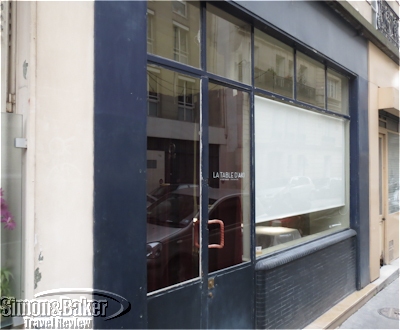
The simple storefront of La Table d’Aki
On our most recent stay in Paris, we dined twice at Table d’Aki, a new neighborhood seafood restaurant led by Chef Akihiro Horikoshi we much appreciated. While some aspects of the experience were less than stellar the meals themselves were outstanding and the reason we plan to return to and recommend the 16-seat unadorned restaurant with a staff of two, the Japanese chef and owner who prepared French food, and a server.
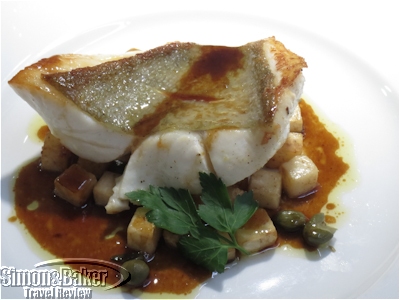
St. Pierre fish over vegetables
The first time we went to the Seventh Arrondissement restaurant with such a discreet sign we almost missed it we were forty minutes late for our 1 p.m. reservation. Although the previous day we had reconfirmed our reservation, as is customary in fine dining restaurants in that city, we had no mobile phone on us and traffic was thicker than we anticipated during our cross city trek resulting in our tardy arrival. An unhappy server allowed us to sit down but informed us, after consulting with the chef of the less than half full restaurant, that we were welcome to stay provided we dispensed with the starter option and only had a main (and dessert we discovered later).

Chef Akihiro Horikoshi
In addition to being eager to sample the cuisine we were hungry so we agreed to the condition. Within minutes we were seated at a window side table with white tablecloths and ordinary dinnerware sipping a glass of disappointingly lukewarm Krug champagne, hoping for a slice of bread and glancing out the window onto the quiet street and indoors at our surroundings. The restaurant had a minimalist design with bare eggshell walls. Individual lamp bulbs hung above each table, suspended from red cordoned leashes that joined together at the ceiling. Tables for two that could be set together for larger groups occupied two rows set against the wall from the curtained entrance to the open kitchen. One row, ours, was longer than the other. A door to the rear left led to a hallway, office and single restroom.
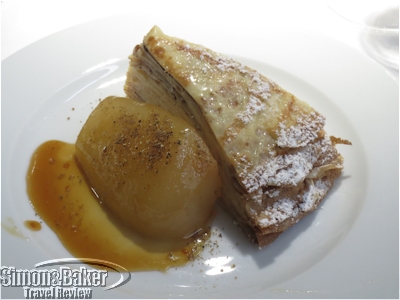
The thousand layer crepe dessert
Moments later a perfectly prepared and seasoned St. Pierre fish, one of two main course options, with a light brown sauce arrived, erasing all unhappy thoughts. Just after bringing the fish to our table the server brought a basket of bread. A thousand crepe with pastry custard was the single dessert on offer. The light yet flavorful dessert completed the meal and left us wanting to return.
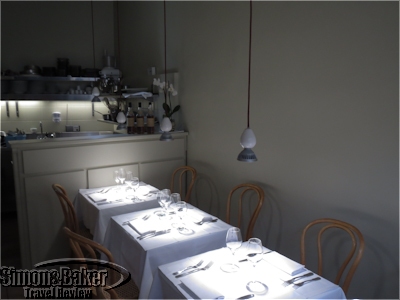
The dining area was adjacent to an open kitchen
Several days later, we were the first guests to arrive for our second meal. The server, the same slender blonde woman from the previous visit, commented on our on time arrival as she took our coats and offered us the table of our choice. Once again the restaurant was less than full for the lunch service. We were surprised to see her turn away two parties that arrived without reservations, explaining with emphasis that reservations were mandatory.
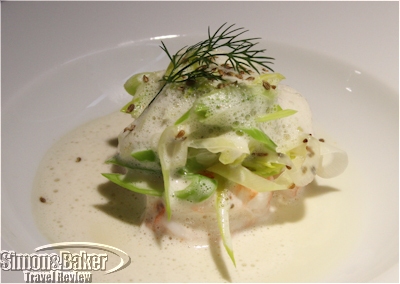
The langoustine appetizer
We overheard one of the parties explain that they had attempted to make reservations but were unsuccessful in reaching anyone over the phone. I empathized as I had trouble myself. The first time I attempted to reconfirm our reservation it took several tries in the space of 90 minutes to get through the busy phone line. The second time I called several times with no response, not even an answering machine.
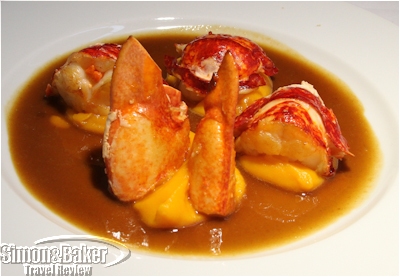
Brittany lobster with brown sauce and mashed pumpkin
On reflection we realized that if they had welcomed the unexpected guests those guests who had taken the time to reserve a table in advance would probably have been left with fewer choices from the limited menu. This policy heightened our opinion of the chef, said to have been a longtime cook at one of the city’s top gourmet restaurants.
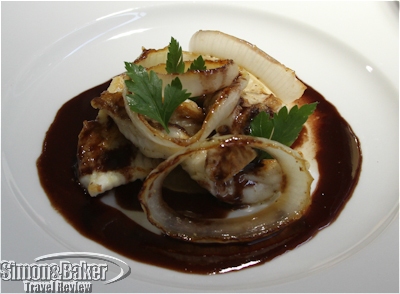
Fillet of sole with onions
From our seats we could see the chef cooking in the clean and well organized looking kitchen adjacent to the dining area. An advantage to the proximity was that our dishes arrived hot straight from the open kitchen (the scent of cooking was at times pervasive although it didn’t detract from our meal). On one occasion when one of our dishes was ready and the server was busy at another table the chef himself brought the dish to our table.
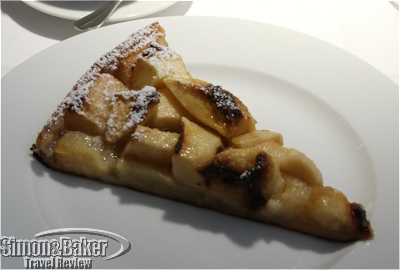
The apple tart
We sampled both appetizers on offer, St. Jacques and langoustine dishes, with favorable results. From the three main courses we sampled two, a small sole dish and a Brittany lobster with two sauces set atop mashed pumpkin (codfish was the third option). Both were delectable although the lobster was our favorite.
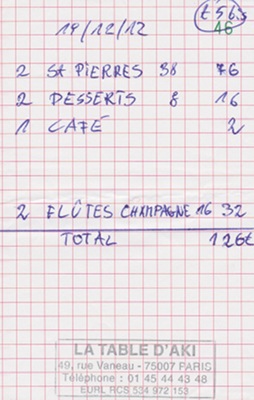
The handwritten bill for our first lunch
We opted for a half bottle of chilled 2010 Pouilly Foume Les Clarieres, a good match for the seafood. Dessert that day was homemade apple tart. Our server explained, when I asked if it had been made there, that the chef made it from scratch including the pastry. It was the perfect ending to a wonderful meal. We look forward to revisiting Table d’Aki (49, rue Vaneau, 75007, Paris, France, +33 1 45 44 43 48) the next time we are in the City of Lights, making sure to reserve a table and arrive on time.
Colmar visit memorable for gastronomic, cultural offerings
Article and photos by Josette King
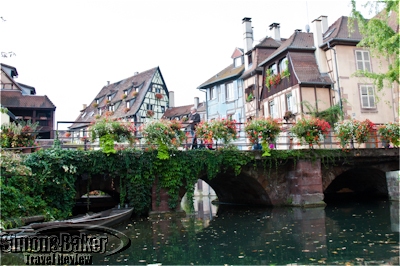
La Petite Venise was once home to tanners and fishmongers
Alsace, this strip of fertile plain stretched along the western bank of the Rhine River in the northeastern corner of France, is a region long on history and charm. The object of a millennium-long tug-of-war between France and Germany, it has successfully integrated elements of both cultures into a unique personality: decidedly French but with a noticeable German flavor in its architecture, arts, cuisine and traditions. And in spite of its troubled past, it has managed to preserve most of its cultural patrimony. Nowhere is that more evident than in Colmar, the medieval architecture gem in the heart of La Route des Vins, the much-visited hundred-mile country road that meanders north to south through the Alsatian vineyards.
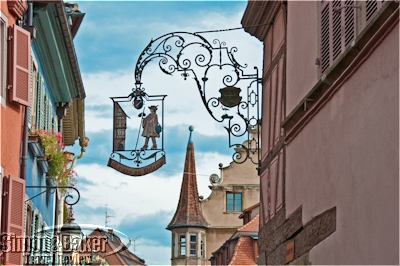
Antique wrought iron signs are still a common sight in Colmar
Mainly spared the destruction of the French revolution and two world wars, Colmar has an exceptionally large and well-preserved historic center for a city its size (population 65,000). I appreciated its laidback small town joviality and its easily walkable cobblestone streets lined with architectural treasures that span eight centuries of combined French and German evolution. At the edge of the historic town, the especially picturesque La Petite Venise (Little Venice) neighborhood is clustered around a network of canals from the River Lauch, where tanners and fishmongers quarters were once located. Farmers also used these waterways to ferry their products to the town market in small pole-propelled wooden barges. Similar barges are in operation today, with silent electric motors, to allow visitors a close look at the ancient (and still inhabited) riverside homes.
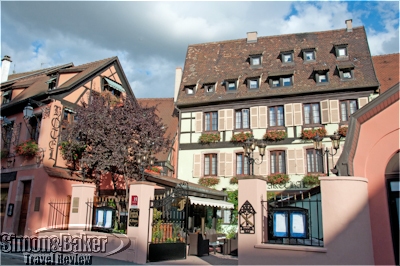
Romantik Hotel Le Maréchal opened onto a private courtyard
One of the finest historic properties of La Petite Venise is the picture perfect Romatink Hotel Le Maréchal. The luxury hotel was created from four adjoining 16th century half-timbered houses with their steep tiled roofs and neat rows of windows underlined with flower boxes overflowing with red geraniums. The rear of the hotel abuts the edge of the river, while the façade opens onto a small private courtyard. Inside, common walls have been opened and passageways link the various common areas with a maze of cozy nooks filled with antiques. An elevator is discretely tucked in a remote corner. My room, located under the eaves at the very top of the property, had slanted beamed ceilings and dormer windows that overlooked the roofs of the old town.
With its rustic Alsatian décor (discretely enhanced by 21st century amenities) it was a charming nest that beautifully captured the romance of the historic city. Equally appealing L’Echevin Restaurant occupied the entire rear of the first floor. There the space had been cleverly distributed to form a long, intimate dining room lined with picture windows that overlooked the river. It provided a worthy setting for the excellent cuisine of Chef Thierry Chefdeville, who has officiated in the kitchen for over a decade, earning such coveted recognitions as two toques from Gault et Millau and three forks from Michelin along the way, and firmly establishing L’Echevin’s standing as a noted destination for Alsatian gastronomy.
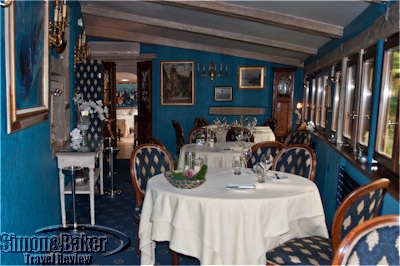
The restaurant, L’Echevin, overlooked the river Lauch
The pleasure of my stay at Le Maréchal, along with a couple of superb dinners at L’Echevin and the opportunity to wander at leisure around neighborhoods of meticulously maintained medieval houses would be reason enough for a weekend break in Colmar, especially now that several daily TGVs (Train à Grande Vitesse) have made it an easy three-hour and twenty minutes ride from Paris. But on this recent visit, there was also the lure of the town’s foremost artistic treasure: the Unterlinden Museum. Housed in a 13th century Dominican Sisters’ convent that is in itself a fine example of Gothic conventional architecture, the Unterlinden Museum holds a rich collection of Upper-Rhenish medieval and early renaissance sculptures and paintings.

Matthias Grünewald’s masterpiece, the Isenheim Altarpiece is on display at the Unterlinden Museum
In addition to works by Lucas Cranach the Elder and Albrecht Dürer, it features several notable altarpieces by 15th century native son Martin Schongauer, and above all what is widely acknowledged as early 16th century master Matthias Grünewald’s greatest achievement: the Isenheim Altarpiece. Originally painted in 1512-1516 for the Monastery of Saint Anthony in Isenheim near Colmar, this unique oil on wood triptych has a center panel 2,70 meter (8 foot 10 inches) high by 3,10 meter (10 feet) wide depicting an especially poignant crucifixion scene. It was customary at the time for such triptychs to open to reveal additional scenes inside.
In the case of the Isenheim Altarpiece, there are actually two sets of wings, therefore two interiors. The first is a set of four panels depicting various scenes featuring the Virgin and Christ. The second interior is a carved shrine containing a polychrome sculpture of Saint Anthony flanked by Saints Augustine and Jerome, by sculptor Nicholas von Hagenau, with two more paintings (the Meeting of Saints Anthony and Paul, and the Torment of Saint Anthony) on the wings to the left and right respectively. In anticipation of its 500th anniversary, the masterpiece had been removed from view for restoration in recent years, and returned on display earlier this year.
Happy New Year!

From all of us at Simon & Baker Travel Review and Luxury Travel Review best wishes for a healthy, happy and bountiful 2013!
New Masai Mara bird book available

Birds of the Masai Mara book cover
In 2010, after arriving in the Masai Mara, Kenya’s famed national reserve, Adam Scott Kennedy, a private safari guide, discovered information and photos about birds in the area were hard to come by. He began taking photos of birds he saw daily to share with guides and before he realized it a book was born, Birds of the Masai Mara (Princeton University Pres, $27.95), this year.
“The biggest challenge in producing this book was completing the species accounts while running a busy luxury camp in the Mara (Naibor), but thankfully my wife Vicki offered to take on the lion’s share of the office work during that period which freed several hours of time for me each day to write,” said Kennedy who already had an extensive image library before the concept of this book came about, from Kenya. “That image library contains around 25,000 images (offline) and our website has around 3,000 images that can be perused at leisure. When we refined the species list for the book, I realised I was missing a few species so had to put myself ‘on assignment’ to get the images required.”
The 176-page softcover book full of color photos mostly taken by Kennedy (some of the photos are from WorldWildlifeImages.com) is divided into Birds of the Plains; Birds of the Marsh and Water; Birds of Woodland, Scrub and Garden; Birds of Acacia Scrub; Village Birds; Forest Birds; Birds of the Air; and Night Birds.
“I began birding at the age of 4 so I guess the biggest reward for me is the response from my friends and family, who are seeing me achieve, what I guess, they always expected me to do with my life,” said Kennedy.
Each bird listing is accompanied by at least one photo and a description. The book lists 300 bird photos and 200 bird species in the area known widely for its wildebeest migration.
Kennedy, also author of Animals of the Masai Mara, and his wife Vicki specialize in photographic and wildlife safaris. According to his website bio, he has seen a third of the world’s 10,000 known bird species.

Click to buy Birds of the Masai Mara
Sommelier writes about well priced wines

Unquenchable book cover
Following the success of her book Red, White and Drunk All Over Natalie MacLean, a sommelier and writer, set about finding well priced wines in several countries. Five years later, the results of her travels and research were outlined in Unquenchable: A Tipsy Quest for the World’s Best Bargain Wines (Penguin USA, $15.99) first published last year in hard cover and most recently in paperback just in time for the end of year holidays. In the 344-page book, written in a conversational style MacLean insists good wine can be found at affordable prices.
She shares wine appreciation and food pairing tips and favorite value wines and wineries from eight regions: North America, Germany, Australia, southern Italy, the Mediterranean, Argentina, Chile and South Africa. She also includes a list of resources for the regions and a list of her notes, wine picks and top value producers in the back of the chapters. In each region she visited between 30 and 40 wineries and tasted thousands of wines. Wine can be complex without being complicated, she says in the book.

Natalie MacLean, author, Unquenchable
“I’ve spent the past several years traipsing around the world, visiting wineries, tasting their offerings, and searching for the world’s best inexpensive wines,” said MacLean in promotional materials. “The narrative is as familiar as Arthur’s quest for the grail and as naïve as the little bird’s plaintive search for the affirmative in Are You My Mother?”
MacLean, named the World’s Best Drinks Writer at the World Food Media Awards in Australia, won the M.F.K. Fisher Distinguished Writing Award from the James Beard Foundation and the M.F.K. Fisher Award for Excellence in Culinary Writing from Les Dames d’Escoffier International. Her wine columns in print reach 5.1 million readers, her complimentary wine e-newsletter has a following of 145,000. For 15 years she was a competitive Highland dancer.
Author photo courtesy of Natalie MacLean, book cover photo courtesy of Penguin Group (USA), Inc.

Click to buy Unquenchable!
Picture book showcases wild cats beauty, endangered state

Fierce Beauty book cover
There was a time not long ago in the history of our planet when one hundred thousand tigers roamed the Earth. Today, less than three thousand remain. Other wild cats are threatened with extinction including the famous King of the Jungle and of course the fast cheetahs because of man’s encroachment on their ancestral homelands. Hoping to draw attention to the plight of these beautiful animals and the link between their and our lives a group of caring individuals pooled their efforts to showcase some animals in photos and draw attention to their South Carolina organization.
Fierce Beauty Preserving the World of Wild Cats (Earth Aware Editions, $50), a 246-page hardcover book published this year, is filled with striking full color photos of many of the large cats that make their home at The Institute of Greatly Endangered and Rare Species (T.I.G.E.R.S) in South Carolina, described in promotional materials as a wildlife education organization, dedicated to promoting global conservation with informative, educational and entertaining interactive programs.
The photos, by Barry Bland and Tim Flach, in outdoor and studio like settings take up a large part of the book which also includes articles by conservation and wild cat advocates, quotes by famous people and biographies of the Institute staff. The book was published in China.
Many of the photos take up a full page or two pages. Tigers, leopards, ocelots, lynx, ligers, cheetahs, panthers and lions in varied colors and ages appear in the photos individually and in groups, alone and with the staff.
The contributors, listed in the back of the book with their photos, are Bhagavan “Doc” Antle, David Barron, founder, International Conservation Caucus Foundation; Lynn Culver, executive director, Feline Conservation Federation; Jim Fowler, zoologist and former host of Mutual of Omaha’s Wild Kingdom; Terry Lincoln, director, Dakota Zoo; Stephen O’Brien, chief, Laboratory of Genomic Diversity at the National Cancer Institute; and Jim Sanderson, founder Small Cat Conservation Alliance. The Foreword is by Robert Duvall.

Click to buy Fierce Beauty







